WILDLIFE
IN MARLOTH PARK
Why is walking not
recommended in Marloth Park?
We appeal to Property owners
not to walk or cycle in Marloth Park, especially after 18h00 or before
06h00. Apart from our resident lions, other wild animals, including
visiting lions, enter on a regular basis. These animals do not disappear during
the day but could be sleeping under the next bush. It is known that the
Marloth Park lions sleep, in Lionspruit or next to the river, during the
daytime. What is unknown is where the "visitors" camp down for
the day!.
Buffalo's are known to circle
a person before attacking and by the time you see these massive bovids it will
be too late. Please be careful as there has already been incidents of this
kind.
The fences are still down and
Property Owners are urgently requested to take the necessary precautions, people
have been observed swimming and fishing in the Crocodile River. PLEASE let
us not, through our actions, give the impression that we are irresponsible and
incapable of the Management of our wildlife. This responsibility can not
be left to others. Let us work and stand together, for only then can we reap
the benefits of our investment.
INTERESTING FACTS
Please keep the following in
mind: You can never outrun a potential
dangerous animal !



| SPECIES |
TOP SPEED (KM/H) |
Man (Olympic
sprinter)
Cheetah
Lion
Leopard
Buffalo
Wild Dog
Warthog
Hyena and Zebra
Rhino & Elephant |
+- 38
112
80
80-90
50-55
48-50
48-50
60-65
40-45
|
DID YOU KNOW..... WARTHOG?
"Warts"
are outgrowths of thickened skin. Males having two pairs (One beneath the
side of eyes, for the protection of eyes during fighting, with a smaller pair
lower down on his snout) Females have one pair below their eyes, smaller than
males. Click photo below..!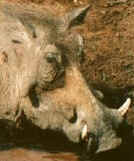
"Tusks"
are enlarged upper & lower canines with a self sharpening action. (Lower
pair rubs against the base of the upper ones, wearing it into sharp pointed
weapons)
Unborn fetus
has callouses on it's knees, developing into pads later in life.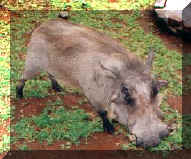
Hyenas
& warthogs as roommates? It has
been recorded that these "roommates" live with a type of
"truce", which is aggressively enforced by the warthog when meeting,
the hyena, at dawn & dusk. Shared burrows do, however, have to meet
special requirements such as having several entrances and chambers.
Mainly a grazer, it also
browses for herbaceous plants, fruit, seeds and flowering grass. The tough
muscular snout is used to grub up rhizomes, earthworms and roots. The tough,
mobile rhinarium (the flat disc containing the nostrils, at the end of the
snout) expose the short green grass underneath. When eating it kneels to get a
better leverage as its neck is short and thick.
Warthogs will occasionally
take carrion and will chase animals like cheetahs of their kills. Piglets eat the mother’s dung to
inoculate their guts with the necessary bacteria. Two sows often live
together and suckle each others piglets ensuring the survival of the litter
should one cow die. Warthogs fall under the
swine family and are even-toed ungulates. Pigs are the only hoofed mammals that
have multiple young. Birth weight is 1% of the mother’s mass, compared to 10%
in antelopes.
DID
YOU KNOW..... SPOTLIGHTS?
After shining a spotlight
on an animal, it takes 30-40 minutes to re-adapt to the dark.
Why
do the eyes glow?
A layer of reflective crystals (tapetum), situated at the back of mammals eyes,
bounces light back to sensitive cells in the retina, increasing the triggering
of nerve impulses. The reflected light causes the eyes to shine.
Although
spotlights do no real damage to the eyes of an animal it does effect the outcome
of the prey / predator situation. Spotlights do however irritate sleeping
Property owners who are/were sleeping. Remember spot lights are not
allowed in Marloth Park and should you, urgently, really, need to use one, do
not shine onto the face of any animal, rather on it's feet.
DID
YOU KNOW..... HIPPO?
When
overheating, hippo's look like they are sweating "blood",
but glands in the skin secretes a bright red, sticky fluid that acts as a
natural sunscreen to prevent the skin from cracking. Hippo's can eat
up to 200kg of grass per night. The Hippo's heart
beat slows down in water to 20 beats per minute compared to the 90 beats per
minute on land.
It is generally believed that more Hippo's kill humans than any other animal
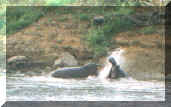
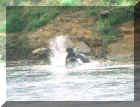
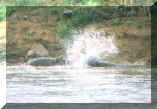
Territorial
males fighting : Marloth Park - July 2000
A hippo’s hide, with fatty tissue, is
about 50mm thick, comprising 16% of it’s body weight. The Hippo has
four toes which makes it an even toed ungulate with each sheathed in a confide
hoof. Therefore the hippo stands on his 2nd to 5th toes.
The average life span of a hippo is 40-45 years.
Similar to other ruminants,
hippo’s have four chambered stomachs but they do not chew cud. Their stomachs
are so large that food can be stored long enough for fermentation to be
effective.
A Hippo society is usually
a basic unit of a dominant male, whose dominance was obtained by combat, a group
of females and young. The groups are territorial and the territory includes a
stretch of water and feeding area. The herd bull, marks his territory by
splattering dung, onto rocks and bushes by wagging his short, flat, and bristle
fringed tail as he defecates. Mothers & young do not
"dung-splatter".
The tusk-like canine, the
lower pair, rubs against the base of the upper tusks in a self-sharpening
action, similiar to the warthog. Hippo's incisors and canines grow
continuously. They show great interest in carcasses but it is not quite
clear if they do anything else but nibbling. Various strange behaviors have been
recorded and filmed, such as rescue attempts and even Hippo’s killing an
Eland, chewing and tossing it around.
Matting occurs in water
with the female completely submerged, only coming up occasionally for breath.
The are only three African mammals that mate in water, the Hippo, Dolphins and
Whales. Females give birth to a 25 to 55kg calve, after a short, compared
with its size, gestation period of approx. 8 months, in shallow water or
secluded densely covered land areas. Infanticide by dominant bulls
does occur.
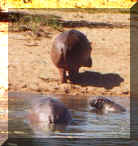 Hippo’s can do a lot of damage to the
environment through the lack of vegetation but all in all the positive
outnumbers the negative. The large quantities of droppings fertilize pastures
and in water supports aquatic life; Fish thrive, water birds and crocodiles
thrive in the presence of fish. Egrets feed on the parasites on the skin of
hippo’s while fish feed on matter that clings to the hippos skin. Water
channels are created and this is important for the flow of water and travel ways
for fish when laying their eggs.
Hippo’s can do a lot of damage to the
environment through the lack of vegetation but all in all the positive
outnumbers the negative. The large quantities of droppings fertilize pastures
and in water supports aquatic life; Fish thrive, water birds and crocodiles
thrive in the presence of fish. Egrets feed on the parasites on the skin of
hippo’s while fish feed on matter that clings to the hippos skin. Water
channels are created and this is important for the flow of water and travel ways
for fish when laying their eggs.

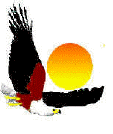 Reg.
No. 98/18384/08 (a Section 21 Co. not for gain)
Reg.
No. 98/18384/08 (a Section 21 Co. not for gain) 
![]()